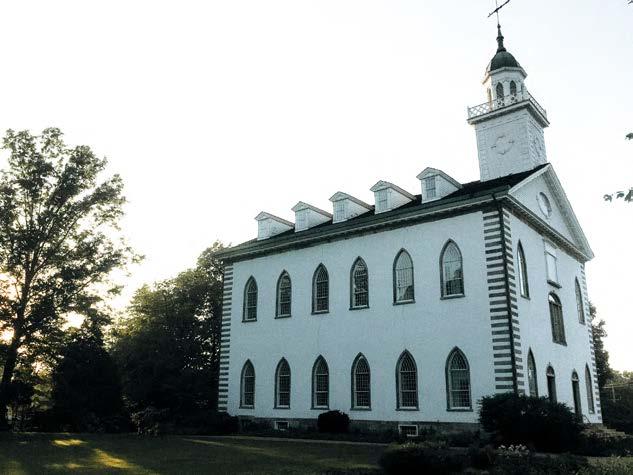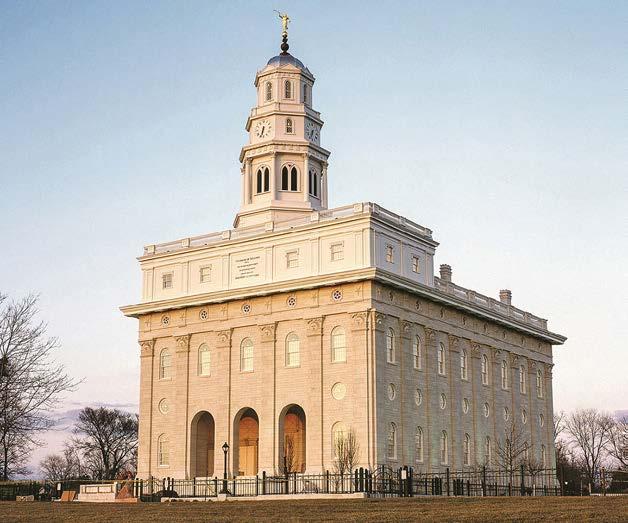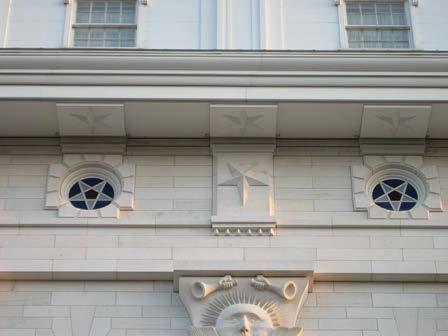
9 minute read
Temples of the Mind and Temples on Earth: Historical Connections between Freemasons and the Latter Day Saints (“The Mormons
BY DR. JOHN BOZEMAN
A Freemason friend once commented to me about the enthusiasm visions which would reveal to him, among other things, a set of with which members of the Church of Jesus Christ of Latter-day golden plates inscribed in a previously unknown Egyptian script. Saints (LDS) visiting the George Washington Masonic National Through divine assistance, the plates were translated and eventuMemorial in Alexandria commented on the symbols found within ally published as the Book of Mormon in 1830, which marked Freemasonry. The visitors the first organized period were struck by similarities The Kirtland, Ohio Temple of expansion of the new with symbols that they had seen in their own buildings. These overlaps in Dedicated in 1836, this temple is similar in design to a New England meeting house. Photo credit: Wyatt Perry Reproduced under Creative Commons license. group as they began to proclaim what they understood to be a restored, fully symbolism, as well as some accurate, understanding of ritual practices and archithe Christian faith. tecture, are actually not coincidental. In this article, Among historians, Smith’s I will discuss some of the movement is called “resreasons behind these simitorationist” because it larities, as well as why this claimed to restore a true history is often not wellChristian faith that had remembered among the been corrupted over the LDS or Freemasons today. years by the addition and The LDS might be said to of the message. There have have begun in the spring of been a number of resto1820. On that day, a fourrationist movements in teen-year-old boy, Joseph the past, both in the U.S. Smith, received the “First and elsewhere; AmeriVision” while praying in The Nauvoo, Illinois Temple We can see the influence can examples include the the woods in Palmyra, of Freemasonry in the Churches of Christ, the New York. The reason for Nauvoo temple, constructed Disciples of Christ, and his prayer was simple: he between 1841 and 1846. also the Adventist moveand his family were believPhoto credit: FFKR Architects ment. Such groups have ing Christians, but young tended to distrust estabJoseph was confused about lished denominations and which of the various relito focus on moral living, gious groups active in the Bible reading, diligence, area was the right one for and a healthy lifestyle. him to join. (Historians call deletion of important parts this region of New York the Smith’s movement fol“Burned Over District” for lowed this general pattern the many revivals that took with a number of imporplace in the area during tant differences. While this time period.) the other restorationists wanted to simplify and In the vision that resulted, exclude what they saw as Joseph was told by Jesus corrupting additions to Himself that none of the the faith, Smith was more competing churches was inclusive and expansive. really correct and that he should not join any of them. A few years The most famous expansion was the Book of Mormon, which later, in a second vision, Joseph received the first of a series of claimed to be the story of Jesus’s appearance, and the establish
Advertisement

ment and eventual fall of a form of Christianity, among the ancient Native Americans. Smith was also familiar with American Indian lore and what some call American folk magic, in part because of his belief that the American Indians were descendants of a lost group of ancient Hebrews. Original Architectural Drawing of There also seems to be a the Nauvoo Temple Weathervane Note the Masonic square and more universalistic side to compass above the Angel. Smith’s thinking as well, namely an openness to the Photo credit: Redrawn from original document by Cordelia Dreisonstok notion the Diety provides various forms of wisdom to all who sincerely desire to live morally upright lives and who engage in self-cultivation.

If the latter ideas sound similar to ideas found in Freemasonry, it might not be a coincidence; we know that Joseph’s older brother Hyrum, with whom he was close, was a Freemason, and so was Joseph’s father. However, as we will see, there would be even closer ties to Masonry in the future.
Yet back to our story at hand. It is now 1830. Joseph is in his mid-twenties. His immediate family supports his visions and his understanding of the Divine Plan, and his movement is getting some traction, growing to about 100 families. Joseph had a vision for a utopian city to be built in the American heartland, and he thus began making plans to move there. However, the group paused in Kirtland, Ohio. The people in the area were particularly welcoming, and one local church congregation converted en mass to the group. During the Kirtland period, which lasted about seven years, the group began calling itself the Latter-day Saints. It grew to about 16,000 members and built its first temple.
While fairly impressive, the temple is also straightforward in design. In fact, the plan for the temple came in the form of a vision to the leaders, and the overall design is rather similar to a New England meeting house.
Around 1838, a financial scandal caused problems in Kirtland. Most of the group moved to Nauvoo, Illinois, where Smith built his second community, and eventually the second temple, and it is in Nauvoo where it appears that Smith fully embraced Freemasonry.
As mentioned earlier, the Smith family was not a stranger to the Freemasons. Once settled in Nauvoo, Smith became friends with Abraham Jonas, a man who was both a Freemason (he was elected Grand Master of the Illinois Grand Lodge in 1840) and a talented politician. Jonas, perhaps noting that Smith’s group tended to block vote, courted Smith and the Latter-day Saints. Jonas also presided at the installation of the Nauvoo Lodge in March of 1842 and, during the installation, proclaimed Joseph and another prominent church leader as “Masons upon Sight.” Within two days both were raised to Master Masons. This started a chain reaction within the Mormon community. Within about two years Nauvoo had five Mormon-sponsored Lodges and about 1400 Mormon freemasons, and a Masonic temple under construction. In contrast, there were fewer than 300 non-Mormon Freemasons in all of Illinois!
Unfortunately, trouble was brewing between the Mormon and nonMormon Freemasons on several fronts. Some was procedural: the Mormon Lodges, perhaps due both to the collective nature of the group and to growth, would ballot on multiple candidates at the same time, a violation of Masonic protocol. Rumors circulated about plural marriage, which would certainly have violated Masonic ethical codes, but even today historians are not completely sure what was going on in regard to this. (Mormon polygamy was only openly practiced later on in Utah.) There were certainly Freemason concerns that Freemasonry was becoming a sort of men’s club within the LDS church.
Inverted Stars in the Windows of the Nauvoo Temple While inverted star windows were fairly common in European Roman Catholic church windows, their uses in sacred art is generally rare in the US. The main exceptions are the LDS Day Star and the Masonic Order of the Eastern Star (OES). Interestingly, the OES formed soon after the Nauvoo Temple was constructed.

We also know that less than two months after Joseph Smith became a Freemason and began serving as the chaplain of his Lodge, he instituted a practice called the Endowment, which contained numerous similarities in structure, wordings, and gestures to the Masonic initiation ritual. Irregularities such as these caused the Mormon Lodges eventually to be suspended and their charters revoked. However, the LDS-centric Lodges generally ignored this censure and continued operating, further aggravating the situation.
Other serious conflicts between the LDS and non-LDS were occurring at the same time, with occasional armed conflicts occur
ring between the two groups. Within Nauvoo, there was also a bitter conflict between the LDS and an anti-Mormon newspaper. These conflicts finally came to a head in 1844; a mob stormed a jail where Joseph and Hyrum Smith were being held in protective custody, and both were killed in the ensuing melee.
Thus began the separation of the Freemasons and the LDS, but it did not happen quickly. After the death of Joseph Smith, most of the LDS followed the leadership of Brigham Young, himself a Freemason. After the group migrated to Utah, interest in Freemasonry declined, in part because Young himself chose not to pursue it further. Later on, when a Lodge was established in Utah by non-Mormons, Mormons were excluded from membership. Over time, the positions in Utah hardened; in 1925 the Utah Lodges uncharacteristically formally banned LDS members from joining, while within the LDS membership in Freemasonry was discouraged. Interestingly, aspects of Freemason iconography remained in LDS architecture and symbolism, as found in both Brigham Young’s house, and also the LDS temple in Salt Lake City.
Detail of the “Beehive House” Brigham Young, leader of the LDS branch that moved to Utah, resided in the famous “Beehive House” which still stands in Salt Lake City. The Masonic Beehive became one of the most beloved emblems of the LDS and later became a central figure in the state flag of Utah.

Happily, relationships between the two groups have improved during the past few decades. The Utah Lodges lifted their ban 1986, and in 2008 a member of the LDS church was elected as the Grand Master. For its part, the Church of Jesus Christ of Latter-day Saints has itself now issued statements stating that LDS membership in Freemasonry is allowed. While there is still discussion about the similarities between the LDS Endowment ritual (which is still central to LDS faith and practice) and Masonic initiation, it is much less strident. Indeed, one might even say that the earlier conflict between Freemasonry and the LDS has been largely forgotten. Perhaps this is not surprising in the United States, which has historically focused more on new beginnings than on old conflicts! However, with improved relations between the Freemasons and the LDS, it is likely that we will see an increasing number of people – Masons, LDS, and persons with membership in both – remarking upon similarities between the two movements, in both ritual and architecture.
Details from the LDS Temple in Salt Lake City Dedicated in 1893, the famous LDS temple in Salt Lake City took 40 years to construct. The temple includes numerous Masonic elements, including the All-seeing Eye of God, the handshake of fellowship, and the use of the Beehive on its ornate doorknobs.

Photo credit: Wiki commons
For Further Reading:
Phillip Y. Freiburg. Freemasonry and Mormonism: The Ignored History. Available at:
https://www.academia.edu/11689093/Freemasonry_and_ Mormonism_The_Ignored_History
Michael W. Homer. ‘Similarity of Priesthood in Masonry’: The Relationship between Freemasonry and Mormonism. Dialogue: A Journal of Mormon Thought. Fall 1994 issue. Available at:
https://www.dialoguejournal.com/wp-content/uploads/sbi/ articles/Dialogue_V27N03_15.pdf
Greg Kearney. The Message and the Messenger: Latter-day Saints and Freemasonry. Available at:
http://www.fairmormon.org/perspectives/ fair-conferences/2005-fair-conference/2005-the-message-andthe-messenger-latter-day-saints-and-freemasonry
Carrie A. Moore. A Mormon Mason: New grand master is the first in a century who is LDS. Deseret News, 29 March 2008. Available at:
https://www.deseretnews.com/article/695265549/A-MormonMason-New-grand-master-is-the-first-in-a-century-who-isLDS.html?pg=2
Michael S. Thomas. Freemasonry and Mormonism. Available at:
http://www.phoenixmasonry.org/freemasonry_and_ mormonism.htm
ABOUT THE AUTHOR Dr. John M. Bozeman holds a master’s degree in European and American religious history and a Ph.D. in science and technology studies. He has taught courses in both religion and in science at several colleges in the Washington, DC, region.










